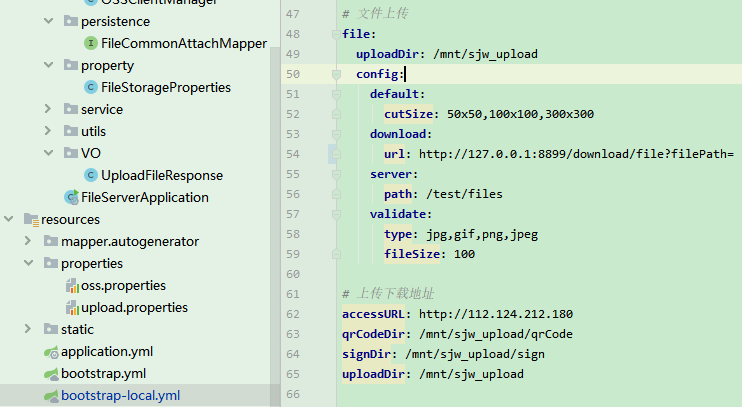spring boot 用@CONFIGURATIONPROPERTIES 和 @Configuration两种方法读取配置文件
spring cloud 读取 配置文件属性值
1、bean
@Data
public class LocalFileConfig {
/**
* 文件存储地址
*/
private String fileServerPath;
private String fileDownloadUrl;
private String defaultCutSize;
private String fileValidateType;
private Long fileSize;
}
配置
@Configuration
@PropertySource(value = { "classpath:properties/oss.properties" })
public class LocalFileConfigConfiguration {
@Value("${file.config.server.path}")
private String fileServerPath;
@Value("${file.config.download.url}")
private String fileDownloadUrl;
@Value("${file.config.default.cutSize}")
private String fileDefaultCutSize;
@Value("${file.config.validate.type}")
private String fileValidateType;
@Value("${file.config.validate.fileSize}")
private Long fileSize;
@Bean
public LocalFileConfig localFileConfig(){
LocalFileConfig localFileConfig = new LocalFileConfig();
localFileConfig.setFileServerPath(fileServerPath);
localFileConfig.setFileDownloadUrl(fileDownloadUrl);
localFileConfig.setFileValidateType(fileValidateType);
localFileConfig.setDefaultCutSize(fileDefaultCutSize);
localFileConfig.setFileSize(fileSize);
return localFileConfig;
}
}

2、
@NoArgsConstructor
@AllArgsConstructor
@Component
@ConfigurationProperties(prefix = "file")
public class FileStorageProperties {
private String uploadDir;
public String getUploadDir() {
return uploadDir;
}
public void setUploadDir(String uploadDir) {
this.uploadDir = uploadDir;
}
}
网上找到第二种方法,级联应用
链接:https://www.cnblogs.com/lihaoyang/p/10223339.html
SPRINGBOOT用@CONFIGURATIONPROPERTIES获取配置文件值
SpringBoot的配置文件有yml和properties两种,看一些文章说yml以数据为中心,比较好。个人觉得properties更好用,所以这里以properties格式为例来说。
我们都知道@Value 注解可以从配置文件读取一个配置,如果只是配置某个值,比如 某一个域名,配置为xxx.domain = www.xxx.com ,这样直接在代码里用@Value获取,比较方便。
但是如果是一组相关的配置,比如验证码相关的配置,有图片验证码、手机验证码、邮箱验证码,如果想把验证码的长度做成可配置。是否能像springboot的配置,

参照着写成:

肯定是可以的!
参照源码是最好的学习方式,下面来看springboot是怎么做的
server对应着一个配置类:ServerProperties(只粘贴出了部分成员变量,来说明问题)
@ConfigurationProperties(prefix = "server", ignoreUnknownFields = true)
public class ServerProperties
implements EmbeddedServletContainerCustomizer, EnvironmentAware, Ordered {
/**
* Server HTTP port.
*/
private Integer port;
@NestedConfigurationProperty
private Compression compression = new Compression();
//省略其他成员变量、getter 、setter
Compression类部分代码:
public class Compression {
/**
* If response compression is enabled.
*/
private boolean enabled = false;
看过后应该很明白了,之所以能写成server.port=8081,server.display-name=lhyapp,server.compression.enabled=true ,是因为 ServerProperties 类上使用了
@ConfigurationProperties(prefix = "server", ignoreUnknownFields = true) 注解,其中prefix 指定配置文件里的前缀, 如果想弄成这样式的 server.compression.enabled = true ,就需要再声名一个类 Compression ,然后在ServerProperties 中引用这个类,属性名对应配置文件中的配置名。
@ConfigurationProperties:
告诉SpringBoot将本类中的所有属性和配置文件中相关的配置进行绑定;
prefix = "xxx":配置文件中哪个下面的所有属性进行一一映射
只有这个组件是容器中的组件,才能容器提供的@ConfigurationProperties功能;
@ConfigurationProperties(prefix = "xxx")默认从全局配置文件中获取值;
下边实现上面说的验证码配置,需要的类:

代码:
CoreConfiguration.java
@Configuration
@EnableConfigurationProperties(SecurityProperties.class)
public class CoreConfiguration {
//配置一些bean
//@Bean
//public XXXX xxxx(){}
}
SecurityProperties.java
@ConfigurationProperties(prefix = "myapp")
public class SecurityProperties {
private ValidateCodeProperties code = new ValidateCodeProperties();
public ValidateCodeProperties getCode() {
return code;
}
public void setCode(ValidateCodeProperties code) {
this.code = code;
}
}
ValidateCodeProperties.java
public class ValidateCodeProperties {
private SmsCodeProperties sms = new SmsCodeProperties();
private ImageCodeProperties image = new ImageCodeProperties();
public SmsCodeProperties getSms() {
return sms;
}
public void setSms(SmsCodeProperties sms) {
this.sms = sms;
}
public ImageCodeProperties getImage() {
return image;
}
public void setImage(ImageCodeProperties image) {
this.image = image;
}
}
SmsCodeProperties.java
public class SmsCodeProperties {
private int length = 4;
public int getLength() {
return length;
}
public void setLength(int length) {
this.length = length;
}
}
在application.properties 里配置
myapp.code.sms.length = 10
使用配置:
@Autowired
private SecurityProperties securityProperties;
@RequestMapping("/length")
public @ResponseBody String length(){
int length = securityProperties.getCode().getSms().getLength();
return String.valueOf(length);
}



